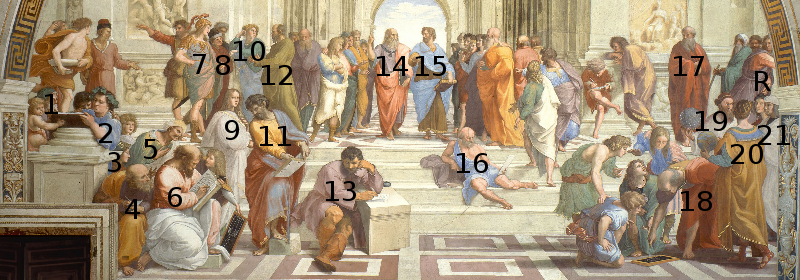The School of Athens
The School of Athens, or Scuola di Atene in Italian, is one of the most famous paintings by the Italian Renaissance artist Raphael. It was painted between 1510 and 1511 as a part of Raphael's commission to decorate with frescoes the rooms now known as the Stanze di Raffaello, in the Apostolic Palace in the Vatican.
The identities of some of the philosophers in the picture, such as Plato or Aristotle, are incontrovertible. Beyond that, the identification of Raphael's figures have always been a matter of conjecture. Scholars have always tended to disagree on many of the other figures, some of whom have double identities as ancients and as figures contemporary to Raphael. The extent of double portrayals is uncertain although, for example, that Michelangelo is portrayed (no. 13 below) is generally accepted.
According to Michael Lahanas, they are usually identified as follows:

The parenthetical names are the contemporary characters from whom Raphael is thought to have drawn his likenesses.
1: Zeno of Citium 2: Epicurus 3: Federico II of Mantua? 4: Anicius Manlius Severinus Boethius or Anaximander or Empedocles 5: Averroes 6: Pythagoras 7: Alcibiades or Alexander the Great? 8: Antisthenes or Xenophon? 9: Hypatia (Francesco Maria della Rovere) 10: Aeschines or Xenophon? 11: Parmenides? 12: Socrates 13: Heraclitus (Michelangelo) 14: Plato (Leonardo da Vinci) 15: Aristotle 16: Diogenes 17: Plotinus or Michelangelo? 18: Euclid or Archimedes with students (Bramante) 19: Zoroaster 20: Ptolemy R: Apelles (Raphael) 21: Protogenes (Il Sodoma, Perugino, or Timoteo Viti)
From Wikipedia, the free encyclopedia
Orfeas Eleftheriou, student of B1 of General Experimental high School Of Mytilene,
Created with GeoGebra
